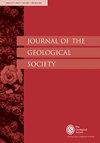南斯科舍山脊白垩纪-古近纪构造重建及其对斯科舍海俯冲开始的影响
IF 3
3区 地球科学
Q2 GEOSCIENCES, MULTIDISCIPLINARY
引用次数: 0
摘要
斯科舍海新生代的发展和德雷克海峡的开放导致了北斯科舍山脊和南斯科舍山脊的地壳块体的分散,这些地壳块体今天对南极环极流的路径产生了强烈的影响。斯科舍山脊地壳碎片平移前的位置是不确定的,与南极和南美洲板块都有相关性。我们介绍了南斯科舍山脊Bruce和Jane河岸的直接地质年代(40 Ar/39 Ar),这些地质年代产生了晚白垩世-古近纪年龄,表明了平移前的岩浆历史。Bruce Bank的玄武岩岩浆作用是钙碱性的,类似于南奥克尼微大陆和南设得兰群岛的新生代岩浆作用,与将南斯科舍山脊的地壳块体置于南极半岛北部弧附近的平移前构造模型一致。Jane Bank的洋弧内岩浆作用年龄为晚白垩世(97.2±1.1 Ma),与表明中新世起源为祖先南桑威奇弧一部分的模型不一致。一些构造模型预测,由于渐新世-中新世祖先弧之前形成的晚白垩世板块动力学,Jane Bank附近向西俯冲的发展。补充材料:https://doi.org/10.6084/m9.figshare.c.6639909本文章由计算机程序翻译,如有差异,请以英文原文为准。
Cretaceous – Paleogene tectonic reconstructions of the South Scotia Ridge and implications for the initiation of subduction in the Scotia Sea
The Cenozoic development of the Scotia Sea and opening of Drake Passage led to the dispersal of crustal blocks of the North and South Scotia ridges that today have a strong influence on the pathway of the Antarctic circumpolar current. The pre-translation positions of the crustal fragments of the Scotia ridges are uncertain, with correlations to both the Antarctic and South American plates. We present direct geochronology (
40
Ar/
39
Ar) from Bruce and Jane banks of the South Scotia Ridge that yield Late Cretaceous – Paleogene ages indicating a pre-translation magmatic history. Basaltic magmatism from Bruce Bank is calc-alkaline, akin to Cenozoic magmatism of the South Orkney microcontinent and the South Shetlands Islands, and in agreement with pre-translation tectonic models that place the crustal blocks of the South Scotia Ridge adjacent to the northern Antarctic Peninsula arc. The intra-oceanic arc magmatism at Jane Bank is Late Cretaceous in age (97.2 ± 1.1 Ma), and is not consistent with models suggesting a Miocene origin as part of the ancestral South Sandwich arc. The development of westward-directed subduction adjacent to Jane Bank is predicted in some tectonic models as a consequence of Late Cretaceous plate dynamics that developed prior to the Oligocene – Miocene ancestral arc.
Supplementary material:
https://doi.org/10.6084/m9.figshare.c.6639909
求助全文
通过发布文献求助,成功后即可免费获取论文全文。
去求助
来源期刊

Journal of the Geological Society
地学-地球科学综合
CiteScore
6.00
自引率
3.70%
发文量
68
审稿时长
6-12 weeks
期刊介绍:
Journal of the Geological Society (JGS) is owned and published by the Geological Society of London.
JGS publishes topical, high-quality recent research across the full range of Earth Sciences. Papers are interdisciplinary in nature and emphasize the development of an understanding of fundamental geological processes. Broad interest articles that refer to regional studies, but which extend beyond their geographical context are also welcomed.
Each year JGS presents the ‘JGS Early Career Award'' for papers published in the journal, which rewards the writing of well-written, exciting papers from early career geologists.
The journal publishes research and invited review articles, discussion papers and thematic sets.
 求助内容:
求助内容: 应助结果提醒方式:
应助结果提醒方式:


